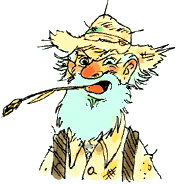Hay & Straw
Hay
- Hay can contain weed seeds, but if you consistently maintain mulch on your garden, the weeds won't have a chance to sprout.
- Hay decomposes slowly and will improve the condition of your soil.
- There are many air pockets in hay which worms love. You can attract them to your garden, and they will fertilize the soil for you.
- Hay is an especially good conditioner for clay soil.
- Use a flake of hay, a strip at least 1" thick (2.5 cm), and place them side by side.
- If you plan to use hay with newspaper, add just enough of it to hold the newspaper down.

Fascinating Facts!
- Hay is a dried grass or legume that is used as animal feed. It's usually cut and dried in the sun before being baled and stored for later use.
- The ancient Egyptians were some of the first people to use hay. They used it as food for their horses and cattle.
- The average bale of hay weighs about 40-60 pounds (18-27 kg), depending on the type of hay and the baling method used.
- In the United States, hay is mostly grown in the Midwest and western states. The top hay-producing states are California, Idaho, and Texas.
- Hay is an important crop for farmers, and it's used not just for animal feed but also for bedding, erosion control, and biofuel production.
- There are many different types of hay, including alfalfa, timothy, clover, and bermudagrass. Each type has its own nutritional value and is suited for different types of livestock.
- The world record for the largest hay bale ever made was set in 2011 in Alberta, Canada. The bale weighed 2,466 pounds (1,119 kg) and was made using a special baling machine.
Straw
- Straw has the same properties as hay, but it has fewer weeds and less nutrients.
- It may contain a few seeds, but the benefits outweigh the drawbacks.
- Straw holds moisture well and adds nutrients to the soil as it slowly decomposes.
Fascinating Facts!
- Straw is not a type of plant, but rather a byproduct of cereal crops such as wheat, oats, and barley.
- The first known use of straw was in ancient Egypt, where it was used to make sandals, baskets, and even paper.
- In the Middle Ages, straw was used to make thatched roofs for houses and buildings. Some of these thatched roofs are still standing today, hundreds of years later.
- Straw can be used to make crafts, such as straw dolls, ornaments, and even hats.
mulch
soil conditioning
|





